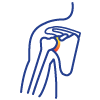
SLAP Tears
What is a SLAP Tear?
SLAP tears stand for Shoulder Labral Tears. The labrum is the soft rim of cartilage that lines the shoulder socket. A SLAP tear is an injury to the labrum, standing for “Superior Labral tear from Anterior to Posterior”. The most common treatment for this injury is a minimally invasive arthroscopic procedure followed by several weeks of physical therapy.
Caused by a tear in the top (superior part) of the cartilage surrounding the shoulder joint, the severity of a SLAP tear can vary. SLAP tears can significantly weaken the shoulder, and can even limit the ability to undertake everyday domestic and workplace tasks.
What Causes a SLAP Tear?
SLAP tears may result from any movement involving the shoulder labrum, from repetitive or heavy lifting at the work, to simply placing a book on a shelf. It is most commonly seen in athletes, particularly with frequent lifting and rotation of the arms. It can also be the product of acute trauma, especially if the arm is subjected to extreme force while outstretched. Degenerative processes can also play a role because the labrum gradually degenerates over time.
What are the Symptoms of a SLAP Tear?
The most common symptoms of a SLAP tear include deep and persistent shoulder pain, limited range of motion, inability to lift objects overhead, as well as locking, popping, and grinding sensations in the shoulder.
Athletes with SLAP tears may feel discomfort when lifting or throwing objects, decreased shoulder strength, or a “dead arm”.
How are SLAP Tears Diagnosed?
Individuals with one or more of these symptoms are encouraged to make an appointment at our Comprehensive Shoulder Clinic, or alternatively to make an appointment with one of our Orthopaedic Surgeons for further assessment and treatment.
SLAP tears are diagnosed by a physical examination, as well as imaging (usually an MRI).
How are SLAP Tears Treated and What is the Outcome?
If your specialist diagnoses a SLAP tear, then don’t worry: as debilitating as they can be at the time, the prognosis is usually favourable. SLAP tears typically don’t result in long-term functional loss if treated effectively. Your orthopaedic surgeon may offer a variety of treatment options, from physical therapy and rehabilitation to surgery. While it is uncommon for a SLAP tear to heal on its own, physical therapy and rehabilitation can sometimes alleviate symptoms if the tear is small and the shoulder is stable.
Where surgery is suggested, in most cases this will constitute a minimally invasive arthroscopic procedure. As with any arthroscopic surgery, your surgeon will make a few small incisions through which to view and repair the damaged labrum and biceps tendon. If the tendon is damaged, every effort is made to repair the labrum and stabilise (or reattach) the tendon. If the damage only affects the labrum, the unhealthy torn flap of the cartilage may be trimmed. The aim of this minimally invasive arthroscopic procedure is to avoid injuries to surrounding muscles, tendons, ligaments, and nerves.
After surgery, it’s recommended that you limit shoulder movement for several days. Your arm may rest in a sling for up to a week, and physiotherapy generally begins 2-3 days post-operatively. You will work closely with your orthopaedic surgeon and rehabilitation physician to ensure the fastest and smoothest recovery. Recovery time varies for each patient. In general, patients feel comfortable performing day-to-day tasks within a few weeks, however full recovery takes longer: maximal strength is generally restored to the labrum at around five months, and strenuous lifting is discouraged before this milestone. Athletes can often resume throwing within three to four months; however a full recovery may take up to six months.


